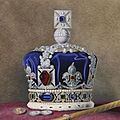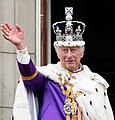Imperial State Crown
| Imperial State Crown | |
|---|---|
 Hand-coloured photograph, published in 1919, digitally altered to resemble the crown's current shorter appearance | |
| Details | |
| Country | United Kingdom |
| Made | 1937 |
| Owner | King Charles III in right of the Crown[1] |
| Weight | 1.06 kg (2.3 lb) |
| Arches | 2 (four half-arches) |
| Material | Gold, silver, platinum |
| Cap | Velvet trimmed with ermine |
| Notable stones | Cullinan II, St Edward's Sapphire, Black Prince's Ruby, Stuart Sapphire |
| Predecessors | Coronation Crown of George IV |
The Imperial State Crown is the state crown of the British monarch. Based on the design of Queen Victoria's Crown of 1838, which had fallen into disrepair, it was made in 1937 for the coronation of King George VI. The crown remains in use today at coronations and State Openings of Parliament. It is adorned with 3,170 precious stones, including the 317-carat (63 g) Cullinan II diamond, St Edward's Sapphire, the Stuart Sapphire, and the Black Prince's Ruby (a large red spinel).
History
[edit]Origins
[edit]St Edward's Crown, used to crown English monarchs, was considered to be a holy relic,[2] kept in the saint's shrine at Westminster Abbey and therefore not worn by monarchs at any other time. Instead, a "great crown" with crosses and fleurs-de-lis, but without arches (an open crown), was a king's usual headgear at state occasions until the time of Henry V, who is depicted wearing an imperial crown of state with gold arches (a closed crown).[3] Arches were a symbol of sovereignty, and by this point in history, the king of England was being celebrated as rex in regno suo est imperator – an emperor of his own domain – subservient to no one but God, unlike some continental rulers, who owed fealty to more powerful kings or to the Holy Roman Emperor.[4]
Henry VII or his son and successor Henry VIII commissioned an elaborate crown, now known as the Tudor Crown, which is first described in detail in an inventory of royal jewels in 1521.[5] Henry VIII wore the crown during court ceremonies, in particular at Christmas when Henry would process to chapel in his coronation regalia.[6] Both Edward VI and Mary I were crowned with three crowns in succession: first St Edward's Crown, second the Tudor Crown (termed the 'Imperiall crowne' in contemporary accounts) and finally in 'very rich' crowns made specifically for each of their coronations.[7] Three crowns were also present at the coronation of Elizabeth I, and she was probably crowned in the same fashion as her predecessors.[7] James I was crowned with only the Tudor Crown, rather than three crowns successively, before wearing the crown made specially for him at the end of the service.[7] The crown continued in use up to the English Civil War and features in many portraits of Charles I.[8][6]
Following the abolition of the monarchy and the execution of Charles I in 1649, all royal crowns were broken up by order of parliament.[9][10] Upon the Restoration of the monarchy in 1660, a new state crown was made for Charles II by Sir Robert Vyner. About 10 versions of the state crown have existed since the Restoration,[11] including the State Crown of George I, made in 1714.[12] George IV had wished his own coronation crown of 1821 to be purchased by parliament and used for state occasions but it was judged too expensive.[13]
Imperial State Crown of Queen Victoria
[edit]
For the Coronation of Queen Victoria in 1838, a new and lighter imperial state crown was created, and this is the basis for today's crown. Made by Rundell and Bridge using old and new jewels, it had a crimson velvet cap with ermine border and a lining of white silk. It weighed 39.25 troy ounces (43.06 oz; 1,221 g) and was decorated with 1,363 brilliant-cut, 1,273 rose-cut and 147 table-cut diamonds, 277 pearls, 17 sapphires (including St Edward's Sapphire, thought to have been taken from the Confessor's ring when his body was reinterred at Westminster Abbey in 1163), 11 emeralds, 4 rubies, and the Black Prince's Ruby (a cabochon red spinel).[14]
At the State Opening of Parliament in 1845, the Duke of Argyll was carrying the crown before Queen Victoria when it fell off the cushion and broke. Victoria wrote in her diary, "it was all crushed and squashed like a pudding that had sat down".[15] Victoria had a small crown made in 1870, which resembled the Tudor Crown,[16] declining to wear the 1838 crown which she found heavy and uncomfortable.[17] In 1909, the larger crown was altered to accommodate the 317-carat (63 g) Cullinan II diamond, also known as the Second Star of Africa.[18]
1937 Imperial State Crown
[edit]A faithful copy of the 1838 crown, which had fallen into a poor state of repair, was made in 1937 by the jewellers Garrard & Co. for George VI.[19] The crown's inner headband was adjusted and its arches lowered by 1 in (2.5 cm) in 1953 for Queen Elizabeth II.[20] The empty frame of Victoria's crown survives in the Royal Collection, and is now on display in the Tower Jewel House,[21] minus its monde and cross which now sit on the current crown.[22]
Description
[edit]| External videos | |
|---|---|
The Imperial State Crown is 31.5 cm (12.4 in) tall and weighs 1.06 kg (2.3 lb), and has four fleurs-de-lis alternating with four crosses pattée, supporting two arches topped by a monde and cross pattée. Its purple velvet cap is trimmed with ermine. The frame is made of gold, silver and platinum, and decorated with 2,868 diamonds, 269 pearls, 17 sapphires, 11 emeralds, and 5 rubies.[23]
Notable stones are St Edward's Sapphire on the top cross, reputedly taken from the ring of Edward the Confessor when he was re-interred at Westminster Abbey in 1163, and the Black Prince's Ruby (a large spinel) on the front cross. In 1909, the 104-carat (21 g) Stuart Sapphire, set in the front of the crown, was moved to the back and replaced by the 317-carat (63 g) Cullinan II.[24] Below the monde hang four pearls, three of which are often said to have belonged to Queen Elizabeth I, but this association is almost certainly erroneous.[25]
Usage
[edit]
The crown is worn by the monarch on leaving Westminster Abbey at the end of his or her coronation.[26] It is usually also worn at State Openings of Parliament, although Elizabeth II wore a hat in March 1974, June 2017 and December 2019 after snap general elections, and in May 2021; and, in October 2019 she wore the State Diadem, while the Imperial State Crown was carried beside her.[27] Usually, it is taken to the Palace of Westminster under armed guard in its own carriage and placed in the Robing Room, where the monarch dons the Robe of State and puts on the crown before giving the speech to Parliament. If a State Opening occurs before a coronation, the crown is placed on a cushion beside the monarch. In 1689, one week after being proclaimed king, William III wore his crown in Parliament to pass the Crown and Parliament Recognition Act 1689.[28] When not in use, the Imperial State Crown is on public display in the Jewel House at the Tower of London.
Gallery
[edit]-
Hand-coloured lithograph of Queen Victoria's Imperial State Crown
-
Queen Victoria depicted wearing the 1838 Imperial State Crown for her coronation portrait
-
Edward VII wearing the Imperial State Crown for his 1902 coronation
-
George V wearing the pre-1937 crown in 1911 in his coronation portrait
-
The emptied frame of Queen Victoria's Imperial State Crown
-
George VI in the 1937 Imperial State Crown
-
Elizabeth II wearing the Imperial State Crown which was reduced in height for her coronation in 1953
-
Elizabeth II wearing the Imperial State Crown from the balcony of Buckingham Palace, 1953
-
The crown on Elizabeth II's coffin, with the Sovereign's Sceptre and Orb during her state funeral in September 2022
-
King Charles III following his 2023 coronation
See also
[edit]References
[edit]- ^ "Crown Jewels". Parliamentary Debates (Hansard). Vol. 211. United Kingdom: House of Commons. 16 July 1992. col. 944W.
- ^ Hoak, p. 59.
- ^ Steane, John (2003). The Archaeology of the Medieval English Monarchy. Routledge. p. 35. ISBN 978-1-134-64159-8.
- ^ Hoak, pp. 55, 63.
- ^ John Plowfeld (1521). "King Henry VIII's Jewel Book". In Edward Trollope (ed.). Associated Architectural Societies Reports and Papers. Vol. 17. James Williamson. pp. 158–159.
- ^ a b The making of Henry VIII's Crown. Historic Royal Palaces. 30 October 2012. Retrieved 4 February 2025 – via YouTube.
- ^ a b c St John Hope, William Henry (July 1902). "The King's Coronation Ornaments". The Ancestor; a Quarterly Review of County and Family History, Heraldry and Antiquities. II. Westminster: Archibald Constable & Co: 63–81. Retrieved 1 April 2025.
- ^ Edward Francis Twining (1960). A History of the Crown Jewels of Europe. Batsford. p. 139.
- ^ Davenport, Cyril (1897). The English Regalia. Kegan Paul, Trench, Trübner & Co. pp. 4–5.
- ^ "An Inventory and Appraisement of the Plate in the Lower Jewel House of the Tower, Anno 1649. Communicated by the Rev. John Brand, Secretary, from the original MS. in his Possession". Archaeologia. 15. London: The Society of Antiquaries of London: 271–290. 1806. doi:10.1017/S0261340900018415. Retrieved 1 April 2025.
- ^ Mears; Thurley; Murphy, p. 29.
- ^ Anna Keay (2011). The Crown Jewels: The Official Illustrated History. Thames & Hudson. p. 195. ISBN 978-0-500-51575-4.
- ^ Kenneth J. Mears; Simon Thurley; Claire Murphy (1994). The Crown Jewels. Historic Royal Palaces Agency. pp. 6–7. ASIN B000HHY1ZQ.
- ^ Tennant, Prof. (14 December 1861). "Queen Victoria's crown". Scientific American. 5 (24): 375.
- ^ "Crown jewels factsheet" (PDF). Historic Royal Palaces Agency. Archived from the original (PDF) on 7 August 2022. Retrieved 9 December 2015.
- ^ "Queen Victoria's Small Diamond Crown". Royal Collection Trust. Inventory no. 31705.
- ^ Fox-Davies, Arthur Charles (1909). . . London: T. C. & E. C. Jack. pp. 358–359 – via Wikisource.
- ^ Mears, et al., p. 30.
- ^ Keay (2011), pp. 174–175.
- ^ Keay, Anna (2011). The Crown Jewels: The official illustrated history. Thames & Hudson. p. 183. ISBN 978-0-500-51575-4.
- ^ https://www.hrp.org.uk/tower-of-london/whats-on/the-crown-jewels/#gs.alpq6k
- ^ "Frame of Queen Victoria's Imperial State Crown". Royal Collection Trust (rct.uk).
- ^ "The Imperial State Crown". Royal Collection Trust. Inventory no. 31701.
- ^ Mears; Thurley; Murphy, p. 30.
- ^ Dixon-Smith, Sally; Edwards, Sebastian; Kilby, Sarah; Murphy, Clare; Souden, David; Spooner, Jane; Worsley, Lucy (2010). The Crown Jewels: Souvenir Guidebook. Historic Royal Palaces. p. 38. ISBN 978-1-873993-13-2..
- ^ The Royal Household. "The Royal Collection: The Crown Jewels". The Official Website of the British Monarchy. Archived from the original on 8 October 2015.
- ^ Shearing, Hazel (14 October 2019). "Queen's Speech: Why didn't the Queen wear her crown?". BBC News. Retrieved 15 October 2019.
- ^ Twining, p. 173.
Bibliography
[edit]- Kenneth J. Mears; Simon Thurley; Claire Murphy (1994). The Crown Jewels. Historic Royal Palaces. ASIN B000HHY1ZQ.
- Dale Hoak (2002). Tudor Political Culture. Cambridge University Press. ISBN 978-0-521-52014-0.
External links
[edit]- "The Imperial State Crown". Royal Collection Trust. Inventory no. 31701.
- "Frame of Queen Victoria's Imperial State Crown". Royal Collection Trust. Inventory no. 75002.
- The Crown Jewels at the Royal Family website











